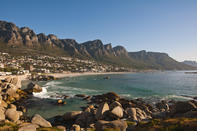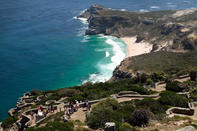Apostles' Circular Walk

Route: From Kloofnek, along Pipe frack, up Apostles and back.
Distance: 11 km
Duration: 3 to 4 hours
Grade: Moderate
This is a good walk for a summer's day; make an early start and you can complete the hardest part in cool shade. The Pipe track alone is a very pleasant walk with imposing views of the Twelve Apostles, Camps Bay and the coast. Remember to take a windbreaker along; after the ascent you might be wet with perspiration and clouds and a wind on the summit will make you very cold and miserable. Probably the best time to do this walk is in summer, when a northwesterly wind brings clouds of cool, moist sea air swirling around the buttresses and playing in and out of the ravine The early morning sun dramatically backlights the ridges, and highlights the streamers of cloud.
Table Mountain Contour Traverse
Route: Lower cableway station to Constantianek
Distance: 18.7 km
Duration: 6 hours
Grade: Moderate
This route may be broken up into a number of shorter variations, for which you should consult a detailed map to check out all the options. When talking of scaling large mountains, climbers speak of 'rubbing noses' with the peak, getting a feeling for its possibilities. In the case of Table Mountain, a circumnavigation is the best way to 'rub noses'. You can include the Pipe frack hike for a long but fulfilling day's hike, but a complete circumnavigation is unfortunately not possible due to private property restrictions above Hout Bay's Longkloof, and the hydrological and botanical research area of Orange Kloof, which is closed to the public. For anyone with an interest in climbing history, the names encountered along this hike should evoke intense nostalgia. The walk is linear, park a car at each end, for transport.
Kanonkop
Route: Bordjiesdrif road to Kanonkop, up Paulsberg and back
Distance: 6 km
Duration: 2 hours (there): 45 mins (back)
Grade: Fair
Booking Authority: Cape of Good Hope Nature Reserve (Western Cape Regional Services Council) (permit needed)
There are three main attractions on this short hike — first there is the signal cannon, after which Kanonkop is named; then there are the views from Paulsberg over all of the Cape of Good Hope Nature Reserve; and finally there are the magnificent wildflowers that make the veld sparkle with colour for much of the year. You will need to pay a small fee at the gate where you will also receive your permit. The reserve is open for day visits only; after the Kruger National Park, it is the most visited conservation area in the country. There is a restaurant in the reserve, which serves lovely tea and scones.
Le Vaillant's Peninsula Traverse

Route: Cape Town to Cape Point
Distance: 60 km
Duration: 3 days
Grade: Severe
Booking Authority: Cape of Good Hope Nature Reserve (Western Cape Regional Services Council) (permit needed)
The name of this somewhat contrived trail celebrates the 18th-century French naturalist who accomplished this feat during his stay at the Cape in 1783. One factor making it easier for him 200 years ago than it is today, was the absence of private property and restricted reserve land - so he could walk and camp where he wished. For years now the many public authorities who control land on the peninsula (city council, regional services council, provincial conservation, state forestry, and various town councils) have spoken about developing a trail down the full length of the peninsula, but so far nothing has been done. The main problem is overnight facilities - there are none. You must plan your overnight stops before setting out. There is a basic route to follow across public land, connected by public roads where necessary. The route is perhaps not ideal, but it is feasible, though you will have to break the walk between Kommetjie and the Cape of Good Hope Nature Reserve. The recommended walk takes three days, and has been planned to make use of already existing facilities.
 Lying at the south-western tip of Africa, the Cape Peninsula is on the Atlantic side of South Africa. A spectacular view of the Cape Peninsu...
Lying at the south-western tip of Africa, the Cape Peninsula is on the Atlantic side of South Africa. A spectacular view of the Cape Peninsu... The major reason for retaining the Western Cape mountains as pristine natural regions is that they are important water catchment areas in an...
The major reason for retaining the Western Cape mountains as pristine natural regions is that they are important water catchment areas in an...